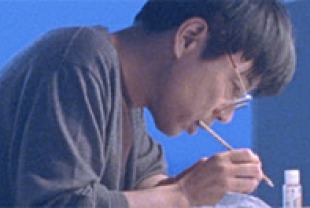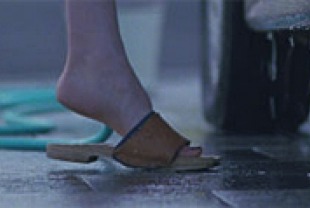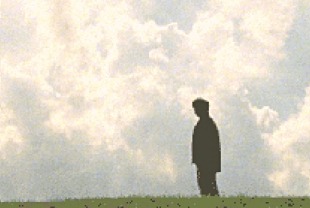FOREWORD:
A recent national survey discovered that one quarter of all adults experience painful loneliness at least every two weeks; the incidence of loneliness among youth is even higher. This feeling is even common in marriages and other intimate relationships. Still, people afflicted with this malaise feel bad about themselves, assuming it means they are lacking something crucial. Loneliness is actually a natural part of the human adventure. Some spiritual teachers believe that this painful experience has an important role to play in our personal development. Certainly, it does no good to run from loneliness; it is better to confront the feelings that arise with it.
THE STORY:
Takitani Shozaburo is a jazz trombone player who spends most of World War II in Shanghai nightclubs. Afterwards he is briefly imprisoned and then returns to Japan where he marries a relative and has a son. His wife dies three days after giving birth, and Shozaburo decides to name his son Tony after an American Army major. Thanks to his name, the boy suffers the stigma of being an outsider. He grows up spending a lot of time alone while his father resumes his career.
Tony (Issey Ogata) eventually becomes a gifted artist. His best drawings are of machines, so he lands a job as a technical illustrator and carves out a profitable career for himself. But the cost of his success is that he reaches middle-age without ever finding time for women. This changes when he takes on Eiko Konuma (Miyazawa Rie) as a client. Tony is mesmerized by how well she wears her clothing and the effort she makes to look well, and he falls in love.
Although he is 15 years older than her, they marry. But there is an emptiness inside her that she tries to fill with extravagant shopping sprees for designer clothes. Tony, for his part, is bothered by fears about losing her and returning to a life of loneliness. Yet he can't help but wonder where her addiction to shopping will lead.
DIRECTOR'S COMMENTS:
Writer and director Jun Ichikawa has based Tony Takitani on a 1995 short story by Haruki Murakami published in The New Yorker. He has fashioned an aesthetically appealing anatomy of loneliness and aloneness that is carried into our consciousness with the quiet voice of a narrator and the musical shadings of Academy Award winner Ryuichi Sakamoto. We were especially impressed with the silences in the story. This approach, which contrasts so starkly with the blatant loudness of so many Hollywood films, compels us to lean forward in our seats and to pay closer attention to the subtle sounds and actions on the screen. Speaking of his approach to this literary work, Ichikawa has stated:
"I have made films based on novels before, but I knew that I could not express the particular tenor of this one, which is both lucid and mild, by taking my usual naturalistic approach. Therefore, I used the narrator as a distancing tool. I also felt that the low tone of his voice would suit the atmosphere. Finally, the narrator allowed me to express parts of the narrative without damaging the serenity of the text or forcing the visual aspect of the movie to be too story-bound. In my efforts to evoke Murakami's world, which is solid, but also floating a few centimeters above reality, I found myself using various strategies. I composed shots with blank spaces, like the paintings of Edward Hopper. I built a simple theatre stage for the shoots and used the same stage for most of the movie, only altering the angles and dressing. I used very few actors and in fact, asked the leads to play two roles each. I decolorized the print to mute the shades. The result is extremely different from my previous films, with a very strange texture."
BEFORE YOU SEE THE FILM:
LONELINESS IN YOUR LIFE
LONELINESS IS A SHORT COURSE IN PERSONAL DEVELOPMENT
"Don't be afraid to be lonely. Loneliness teaches us what we lack — and what we don't. Loneliness is a short course in personal development," Joan D. Chittister has written in The Psalms: Meditations for Every Day of the Year.
MAKE FRIENDS WITH YOUR LONELINESS
In Joy, No Matter What, Carolyn Hobbs suggests: "Next time loneliness lands in your lap, create some open time to get to know it. Close your eyes, take some deep breaths, and ask your higher wisdom: 'What triggered my loneliness? How does it feel in my body? What past memories feed it? What stories does it trigger? What feelings come with it, or follow it?"
BEING ALONE CAN BE GOOD
"Loneliness is the desire for someone; being alone is contentment," observed Tom Seeley.
LOVE & LONELINESS GO TOGETHER
In his book The Road of the Heart's Desire, John S. Dunne quotes poet Wendell Berry: "Even love must pass through loneliness Wendell Berry says."
SHOPPING AS A STAY AGAINST LONELINESS
In Attention Shoppers!, Eve Eliot writes: "While shopping for the missing, underdeveloped or disowned parts of the self is a theme in many people's unconscious impulses to go shopping, the social side of shopping is also a significant motivator. Loneliness brings many people to the marketplace, shopping for company."
LONELINESS COMES FROM ABANDONING OURSELVES
"The only real loneliness comes from abandoning ourselves, from not being who we are. Then we turn to another to fill us. When we operate in this fashion, no matter how many people are in our world, we feel abandoned and alone," wrutes Brenda Shoshanna in Zen and the Art of Falling in Love.
CONNECTING WITH YOUR GLOW-IN-THE-DARK SELF
"Loneliness is a phantom feeling. You're never alone once you've made a connection to your mysterious, multifaceted, diamond, glow-in-the-dark self," writes Gabrielle Roth in Connections.
OTHER FILMS EXPLORING LONELINESS & ALONENESS:
AFTERWORD:
Loneliness is a natural human emotion, like sadness and grief. It has the potential for a positive impact on our lives. It can be a catalyst to greater creativity: it can sensitize us to the needs and yearnings of others. It can open us to the wonder of our essential self.



